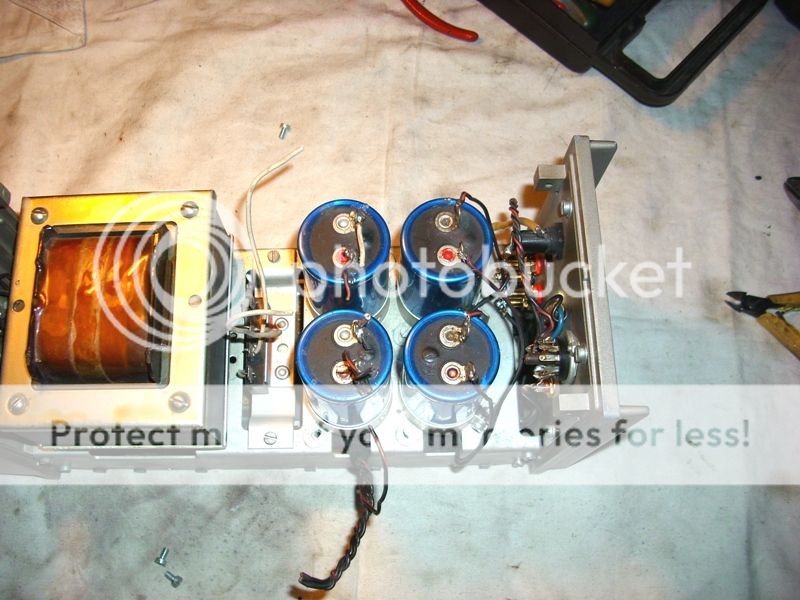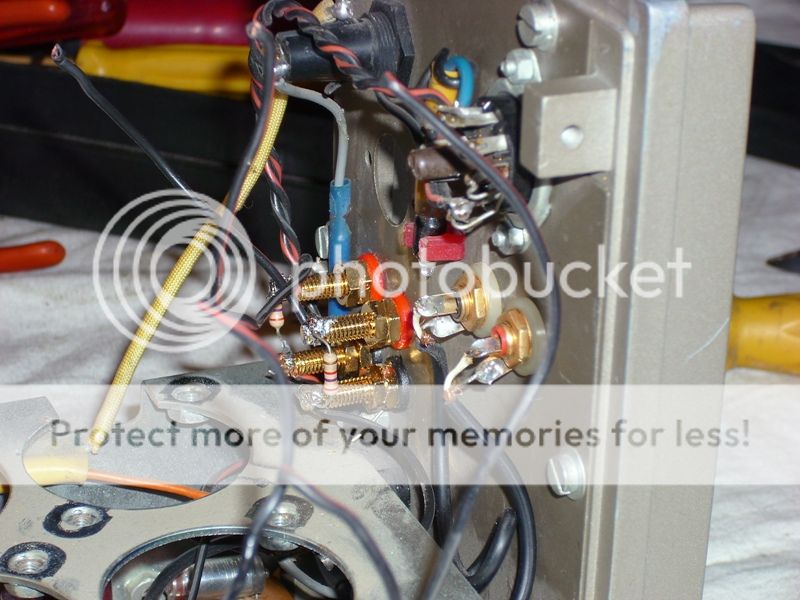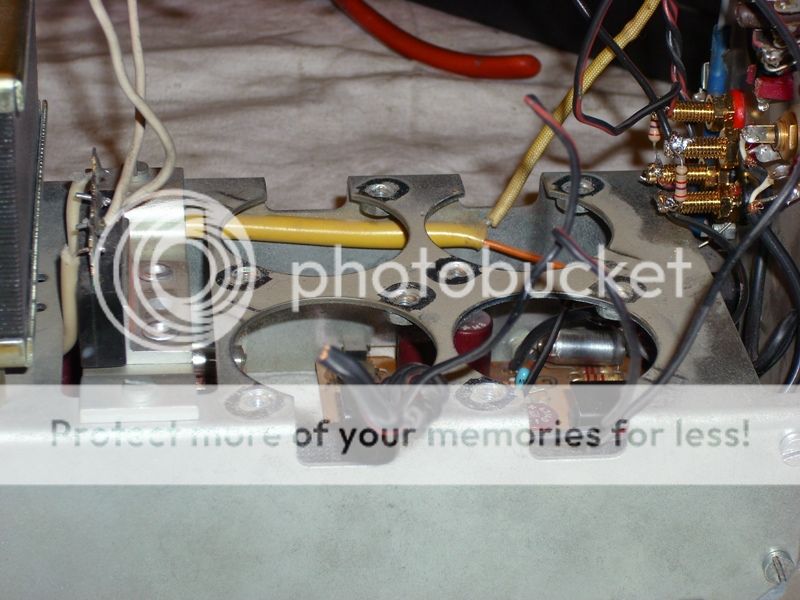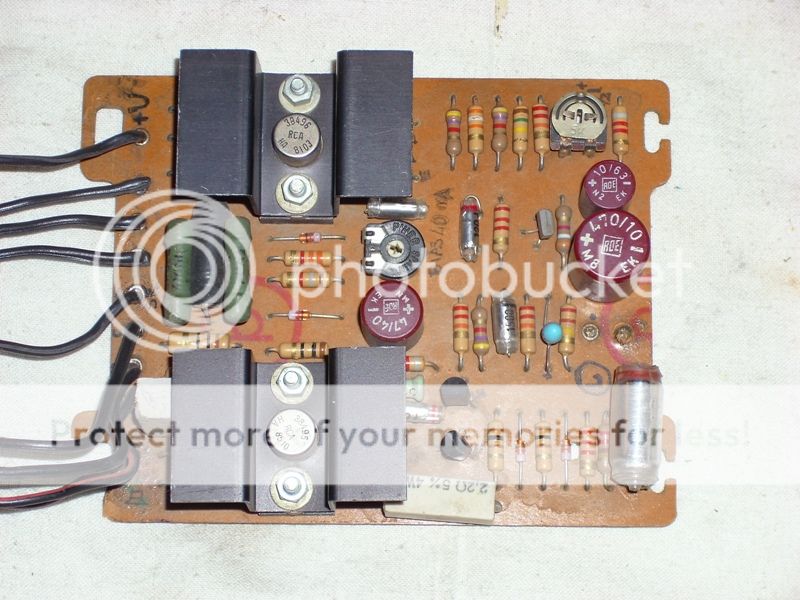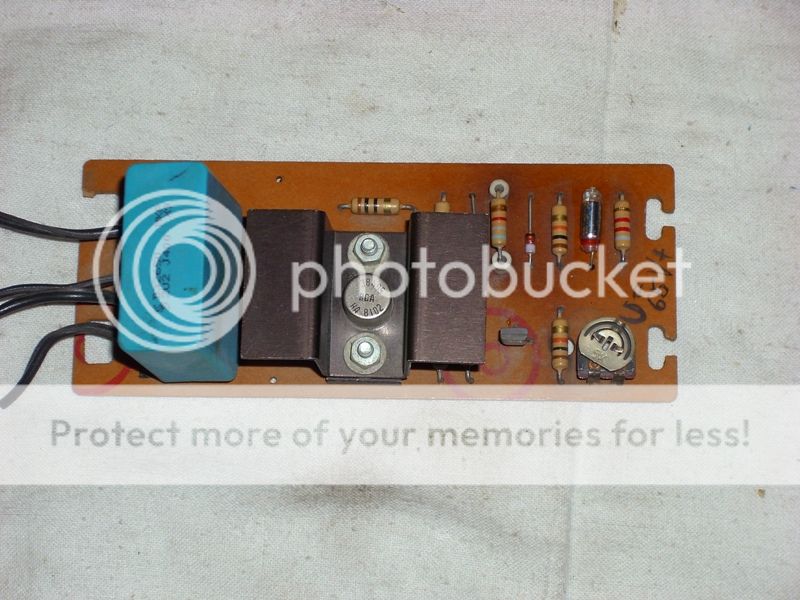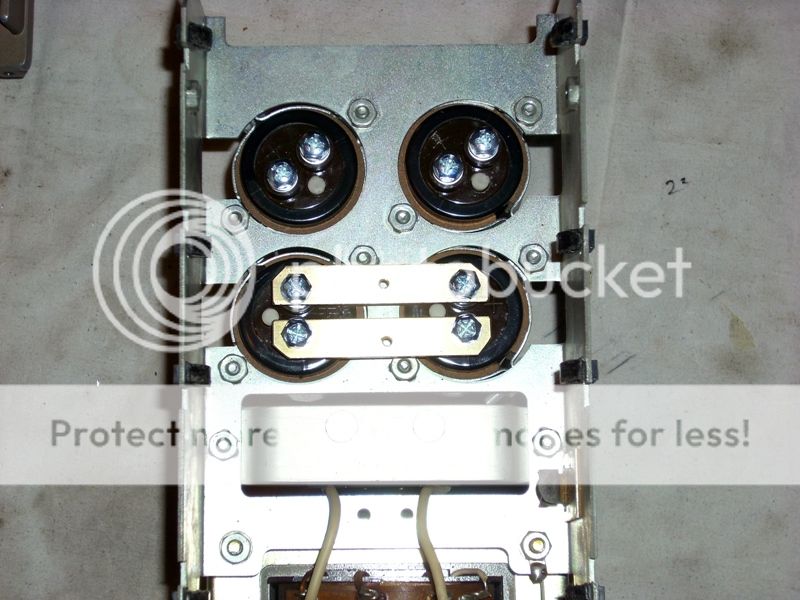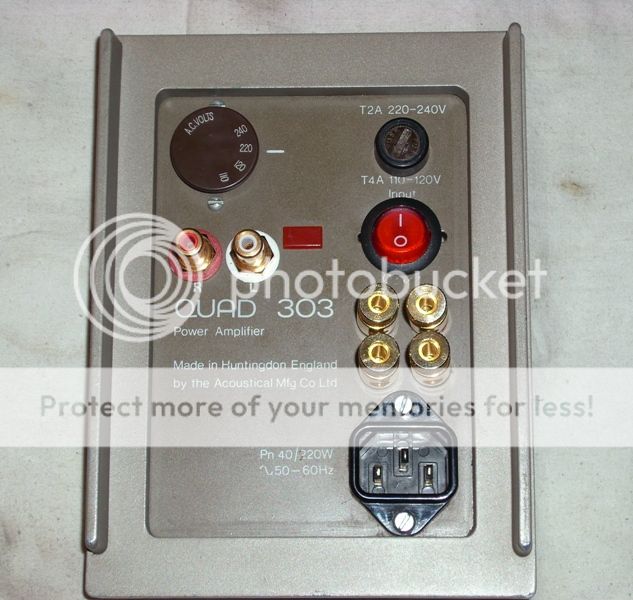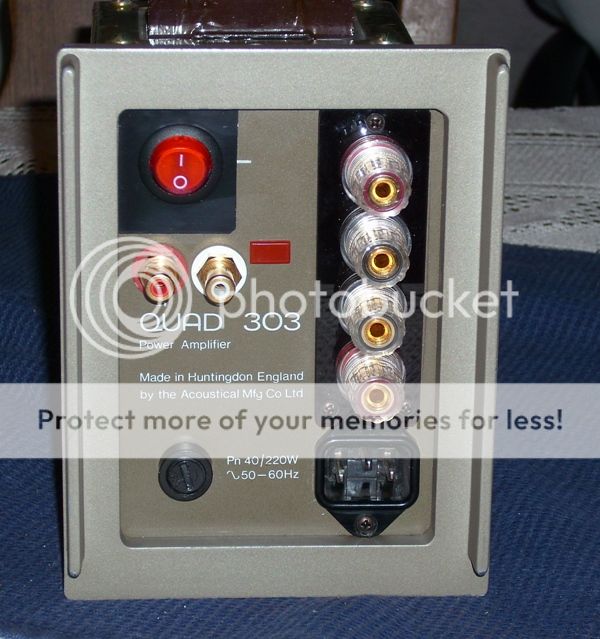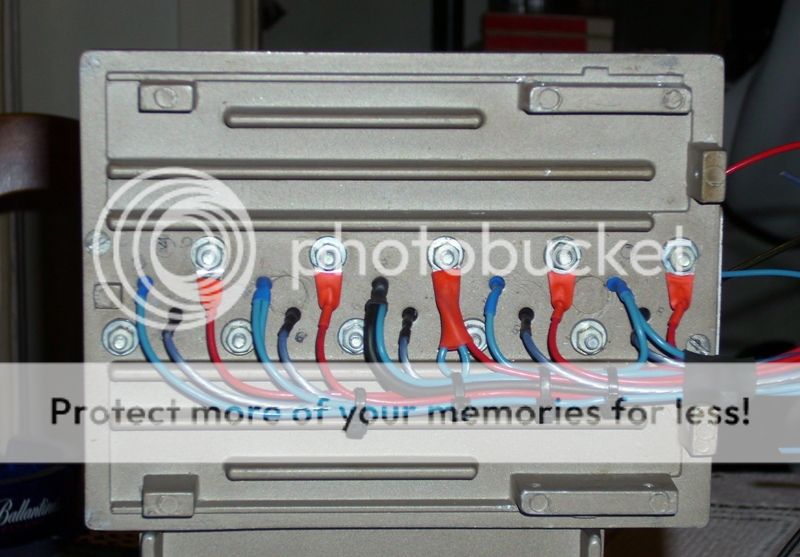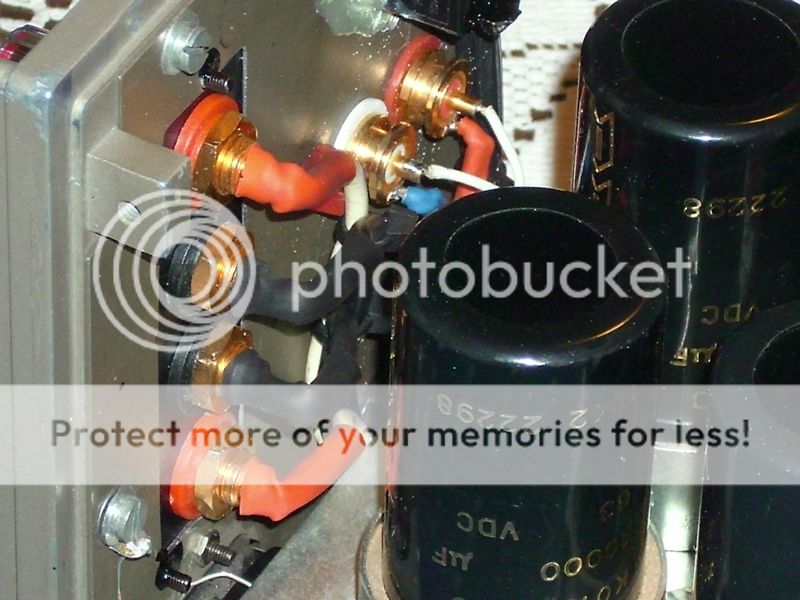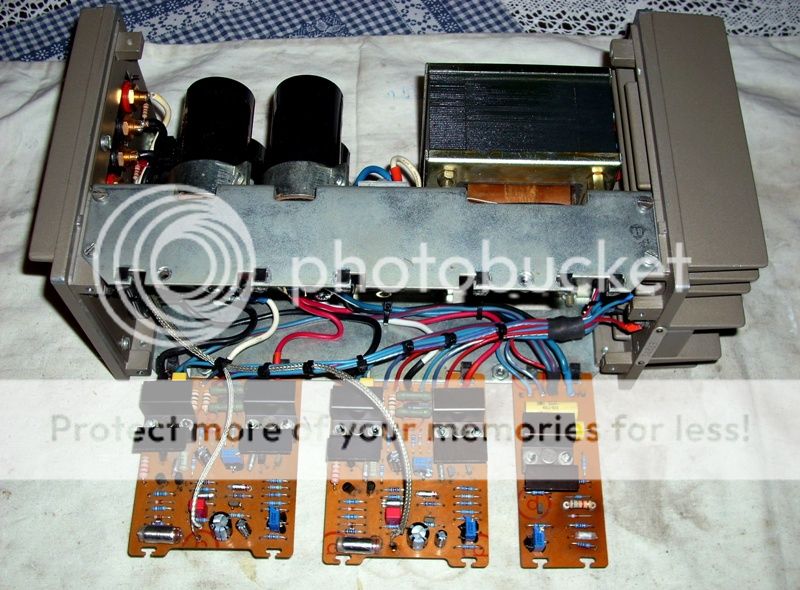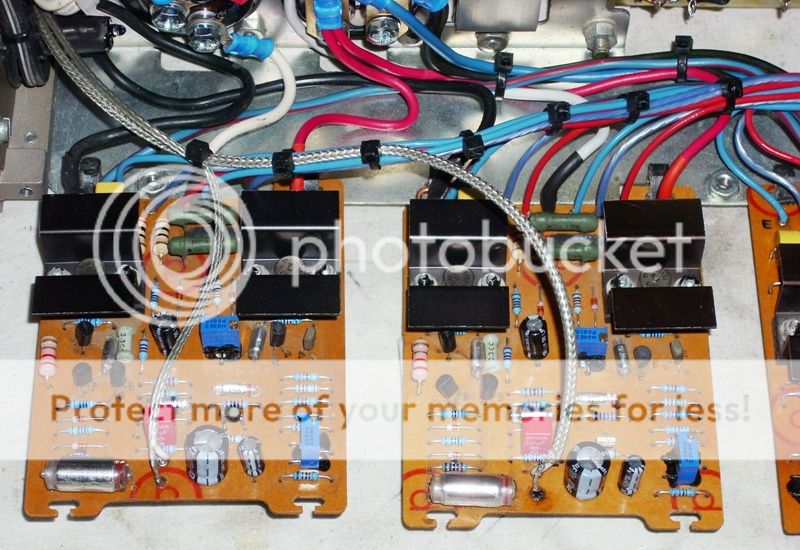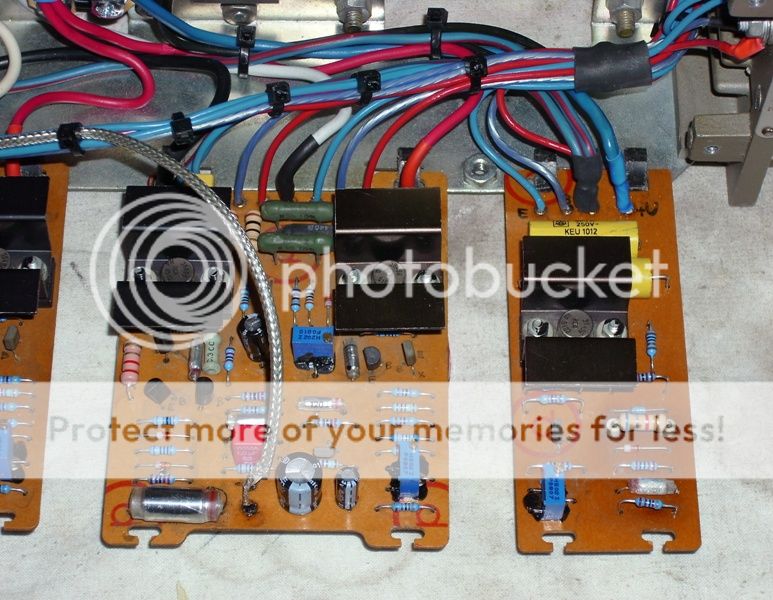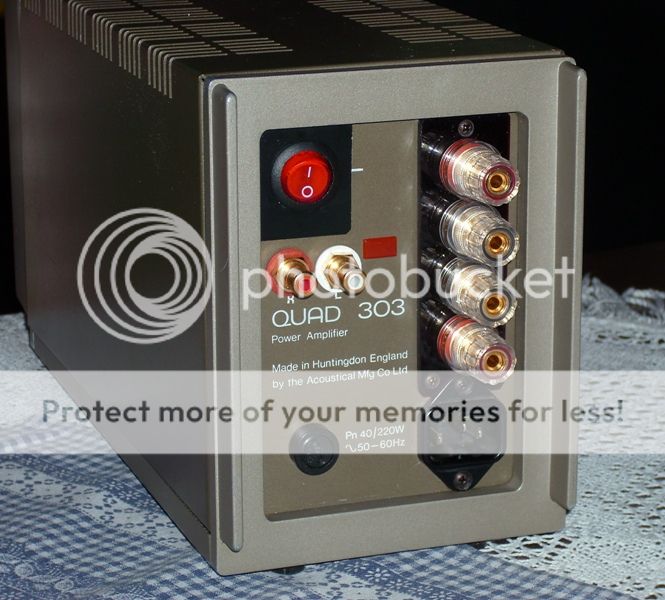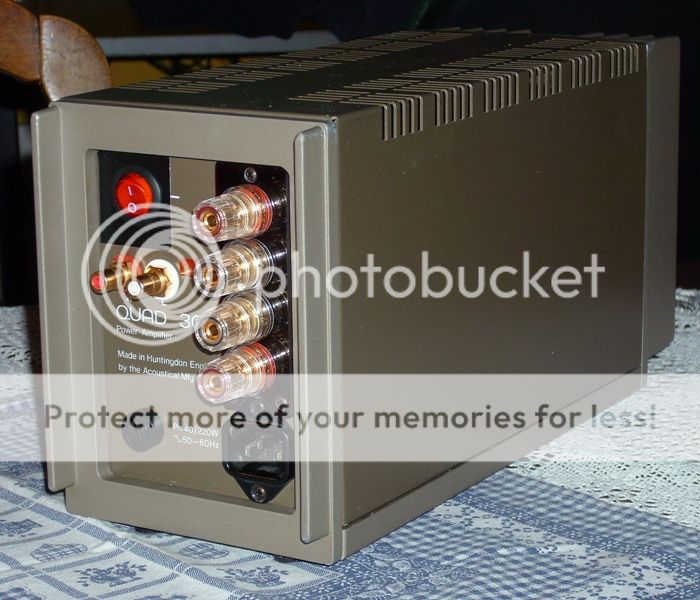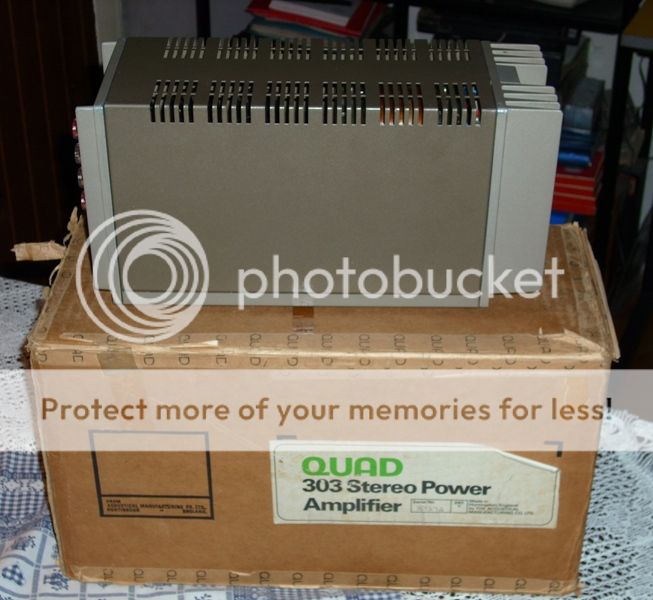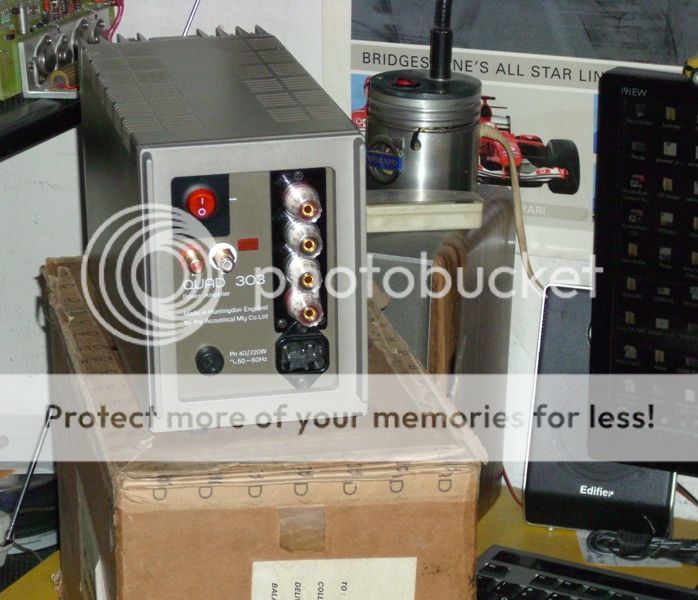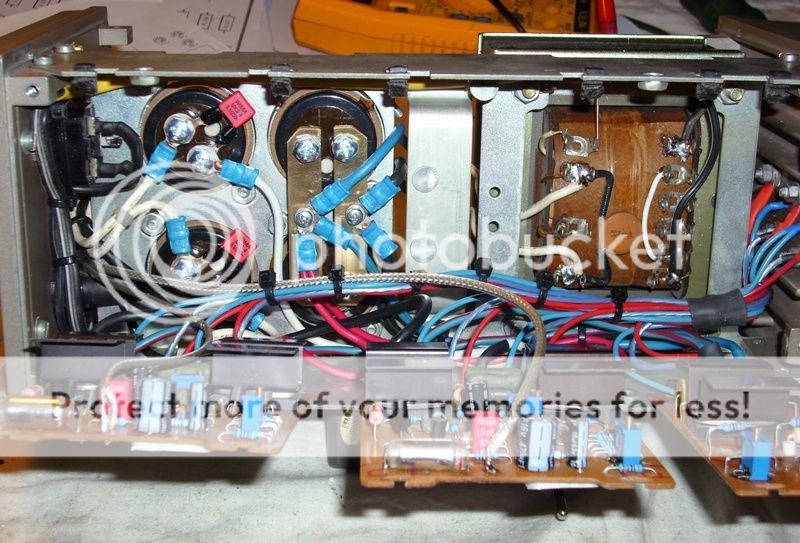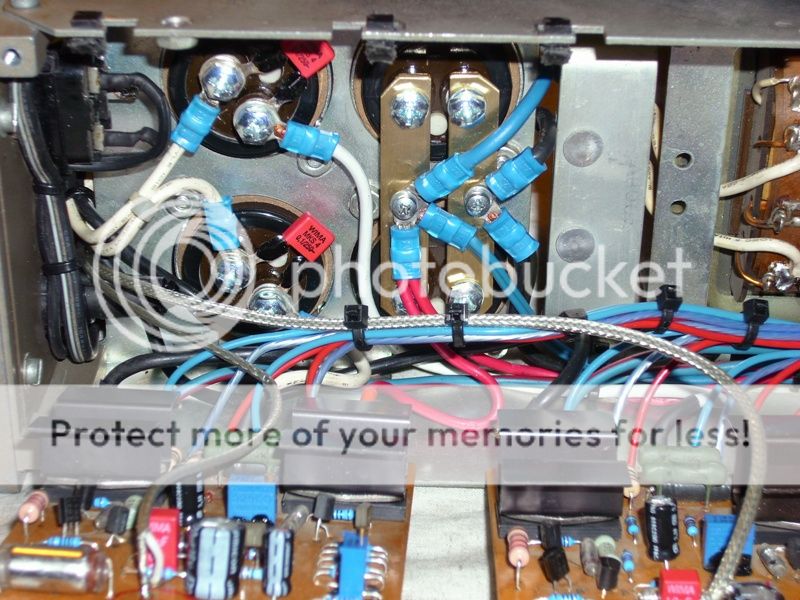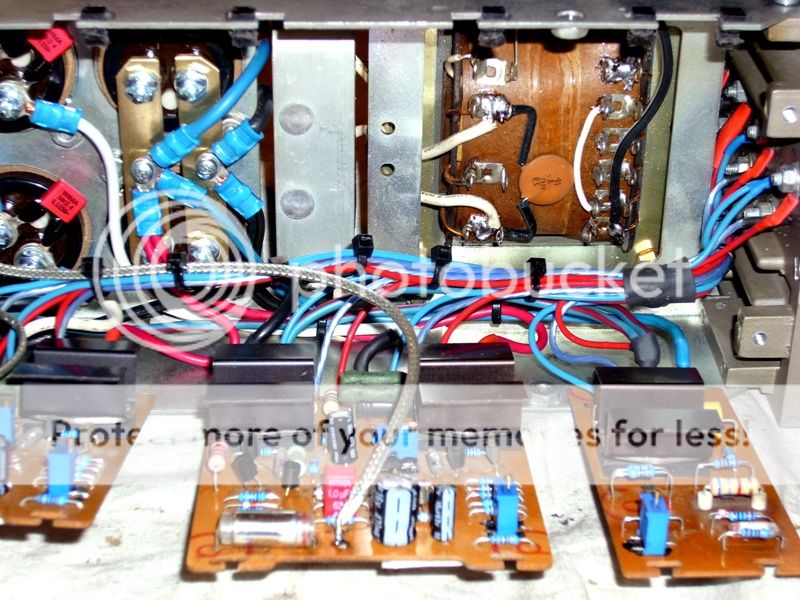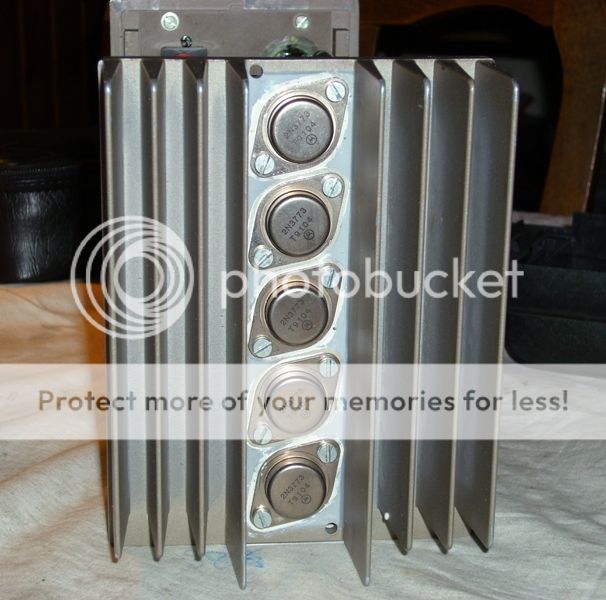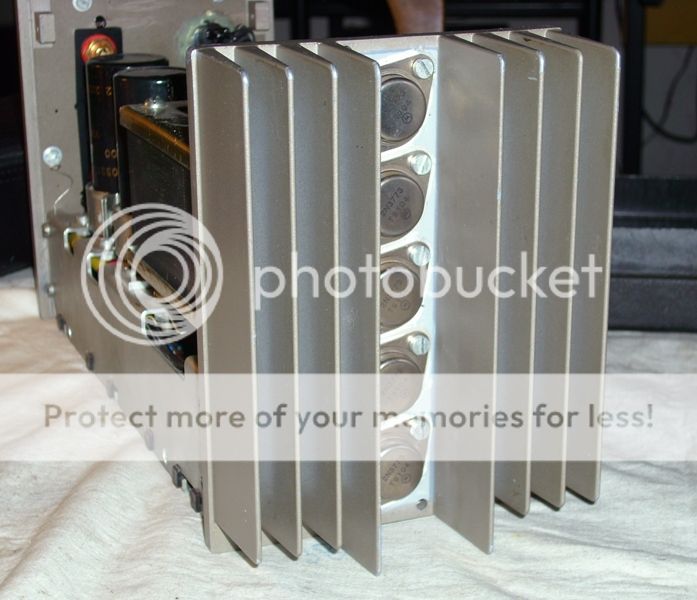Hi, I've owned a 303 for a year or so now, it had the original capacitors so I refurbed it with the Net Audio capacitor kit and replaced the butchered front plate with a home made one which included proper input and output sockets and some decent mains in and out sockets. So it's "sort of" original (at least sound wise). I use it with my 57s. and I like the results. (Incidentaly I use a DAC to feed it, am I the only one? Most people seem to spend time and money upgrading their Quad pre amps and still people knock them).
I just bought (maybe unwisely) another 303 and I'm tempted to go the whole hog and get the two mono Net audio full upgrade kits. Has anyone gone down this road and is brave enough to give a truthful (not coloured by expenditure!) report of the outcome? Will I loose the Quad sound as some people say (do they actually know this to be so or is it just a desire to keep originality?). I suppose that if I do the upgrade and don't like it I can always put my first amp back as it is now and sell the second one with all the upgrades.
So, should I stick with what I have, or am I missing out on the 'wonders' of Mk3 upgrades and the 'essential' benefits of monoblocking to get the best from my 57s?
Some objective help, maybe on the outcome of each part of the upgrade process, required here!
I just bought (maybe unwisely) another 303 and I'm tempted to go the whole hog and get the two mono Net audio full upgrade kits. Has anyone gone down this road and is brave enough to give a truthful (not coloured by expenditure!) report of the outcome? Will I loose the Quad sound as some people say (do they actually know this to be so or is it just a desire to keep originality?). I suppose that if I do the upgrade and don't like it I can always put my first amp back as it is now and sell the second one with all the upgrades.
So, should I stick with what I have, or am I missing out on the 'wonders' of Mk3 upgrades and the 'essential' benefits of monoblocking to get the best from my 57s?
Some objective help, maybe on the outcome of each part of the upgrade process, required here!
Read someone who doesn't have a financial or singular interest in their "upgrade" kits or services. The same is true everywhere of opinions expressed by owners who accept glib high-end audio sales pitches and buckle to the snobbery of the devotees.
You will not get valid opinions within the experience of Quad devotees because money is at the bottom of upgrades and having spent it, we naturally feel it is going to be justified - if not, why do we keep modding and modding our gear into nothing original? Is only the case and transformer worth keeping? It is also worth noting how little most modified audio is worth, compared to that in original condition, whatever opinion holds as better performance or whose ideas were implemented.
My suggestion is to limit enthusiasm to rational ideas and procedures that genuinely improve the usefulness and preserve the sound quality of the original, such as those by Keith Snook, whom I'm sure you're aware of. Otherwise, play about rebuilding with inexpensive clone boards which are every bit as good as the originals.QUAD 303 Amplifier modification to general purpose Lab amp from 303 A2
You will not get valid opinions within the experience of Quad devotees because money is at the bottom of upgrades and having spent it, we naturally feel it is going to be justified - if not, why do we keep modding and modding our gear into nothing original? Is only the case and transformer worth keeping? It is also worth noting how little most modified audio is worth, compared to that in original condition, whatever opinion holds as better performance or whose ideas were implemented.
My suggestion is to limit enthusiasm to rational ideas and procedures that genuinely improve the usefulness and preserve the sound quality of the original, such as those by Keith Snook, whom I'm sure you're aware of. Otherwise, play about rebuilding with inexpensive clone boards which are every bit as good as the originals.QUAD 303 Amplifier modification to general purpose Lab amp from 303 A2
Ian summarized it efficently...
On the technical side it is worth pointing that the only valuable
mod on such an amp is to increase the output capacitance to get
lower distorsion at low frequency as well as better frequency response.
For the rest , the perfs are surprisingly good with the original amp
and wont be improved significantly with any other modification than
the one above..
On the technical side it is worth pointing that the only valuable
mod on such an amp is to increase the output capacitance to get
lower distorsion at low frequency as well as better frequency response.
For the rest , the perfs are surprisingly good with the original amp
and wont be improved significantly with any other modification than
the one above..
I've owned at least a dozen Quad 303s. The most dramatic work i did on them is outlines here: Quad 303 monobloks
When i listened to my last one i switched from a 3875 chipamp. Quickly flipped the 303 and said to myself, never again unless it is at a give-away price. I love the chassis.
dave
When i listened to my last one i switched from a 3875 chipamp. Quickly flipped the 303 and said to myself, never again unless it is at a give-away price. I love the chassis.
dave
303 forever!
Regards zeoN_Rider
Wow, man, you must LOVE your 303's! That is epic work.
I traded mine in on a 405 back in nineteenmumblymum and was never sure I did the right thing....
Still got a soft spot for the old fella and it's 33 companion.
Those and my Sugden P51/C51/T51 are the only amps I ever regret selling. Oh, and the Astronic 1222s as well. And the Haflers. Maybe the Meridians too. The Krell? Happy to see the back of it. And don't get me started on the bloody Metaxas.........
Rgds,
blakksmokemits (from the Metaxas, mainly)
ps. I agree with Dave. A decent chip amp kills them. But I kind of wish I was listening to one now even so.... Nostalgia - It's free!
pps. Oh, and the Cambridge P40 that blew up every second Tuesday. It sounded great for the thirteen days in between!
Last edited:
Love the work you have done.
To answer the original question you need to change all the electrolytic capacitors as these are the parts that fail with age as the electrolyte dries up. Don't worry too much about specs as any current capacitor you buy will be better than its 1970s' counterpart and return the amp to its original sound, if not better. Mains cable should be at least the 40 strand 13 amps mains type.
To answer the original question you need to change all the electrolytic capacitors as these are the parts that fail with age as the electrolyte dries up. Don't worry too much about specs as any current capacitor you buy will be better than its 1970s' counterpart and return the amp to its original sound, if not better. Mains cable should be at least the 40 strand 13 amps mains type.
I had a go at upgrading a 303 with serial number 84XXX. I went pretty far, recapped, put MJ15003 output transistors on (kept it NPN-only output), new input stage transistor, silver input cable, better speaker terminals & cable, chunkier Power supply and output filter capacitors, new trimpots, I did the inductor and diode mod to increase the output current, and replaced the bridge with MUR diodes. I then powered her up. She sounded a BIT better, but I was very frustrated that it still had a very limited soundstage (like the sound was "stuck" L & R in each speaker), and horrible horrible brittle highs that rolled-off like a valve amp response, resulting in very little definition & detail. I was actually all ready to relist the amp on the auction site where I found it. THEN I replaced the horrible 38495 & 38496 driver transistors on the amplifier PCBs with 5320 & 5322 transistors, and lordy lordy - she opened right up with a nice spread-out soundstage, massive amounts of nice smooth topend response (nice and sweet topend) and tons more detail. If the "quad sound" is what this amp is meant to sound like before I made this last change, then you can keep it! The 303 is now currently the best amp I've ever heard or owned. I'd thoroughly recommend this mod to anyone with this amp. It truly unlocks the amp's true potential.
I wonder if any of you has a scope ....nothing else ...
(twisting power supply cables , with ground , with signal, with input, with output,with base leads ,with emitter leads, with collector leads , and all of these times X 2 since we have 2 channels WILL RESULT that at some point that the mess of cables will MODULATE the base leads with catastrophic results times X2 if load is more capacitive )
This type of modulation will insert various types of harmonics in the signal which easily can be perceived as "" unique sound"' BUL to my understanding , expect crosstalk to hit the sky and a zillion of other problems like oscillation or inter modulation and any form of this type of interaction to be present and pollute your signal ...
The number one thing one should to is to re arrange wiring separate channels but most important keep the base cables free of problems
Kind regards
a ...Japanese Lover
(twisting power supply cables , with ground , with signal, with input, with output,with base leads ,with emitter leads, with collector leads , and all of these times X 2 since we have 2 channels WILL RESULT that at some point that the mess of cables will MODULATE the base leads with catastrophic results times X2 if load is more capacitive )
This type of modulation will insert various types of harmonics in the signal which easily can be perceived as "" unique sound"' BUL to my understanding , expect crosstalk to hit the sky and a zillion of other problems like oscillation or inter modulation and any form of this type of interaction to be present and pollute your signal ...
The number one thing one should to is to re arrange wiring separate channels but most important keep the base cables free of problems
Kind regards
a ...Japanese Lover
Last edited:
With limitations of the 303 case style and size it is very difficult to distance loudspeaker, input and PSU conductors properly. Many people in UK objected to the practices that QUAD used (thin internal cables, bunched together signal, output, PSU, etc.) among others Ben Duncan. But QUAD peole were stubborn. The main reason for this is that they insisted that amp enclosure should be as small as possible. 303 used these particular dimensions because carton package of 303 were supposed to be the same as for previous QUAD II valve amplifier!
But I must admit that the circuit itself is first rate even by today's standards. Many things that I like here: current feedback topology and triples output stage. I do not perceive single supply as shortcoming and not even capacitor coupled output. This could be great amp if modern parts are used and cabling problem solved.
Hi
I found this thread whilst looking for information on changing the inputs on my Quad 303 amplifiers, I may also do some some cap and other component changes when I do this work. So even though this is an old thread I felt I would join diyAudio and see if someone can help me.
I notice that Quad 303s pictured here have phono connectors fitted, are these connected to the original DIN connections inside or is there any other matching changes that should be done? My understanding has been that DIN is quite a different standard to phono line level; although the Quads are the only equipment I have that uses them for analogue line connection.
I no longer wish to use the 33 preamplifier as I think it is not up to the standard of the 303 power amplifier, which I feel was a milestone in amplifier development and still holds it's own today. I'm tempted to add XLR connectors as well - something that I have seen done to 303s in professional service at radio stations - but there seems little point unless I balance the inputs and even using a very good transformer is not going to improve the sound although it might help with matching to some of my professional equipment.
These Quad 303 amps are getting old now so some new components probably would be a good idea and I may well take up slimecity's suggestion of replacing the 38495 & 38496 driver transistors, I would be interested to see what difference that makes but I'll do the caps first to try to get the amps performing as they did when they were a lot younger.
I say amplifiers as my living room and system has to serve many uses; as a recreational stereo music listening room, a surround sound home cinema room, a professional listening room and a home studio. I have 3 x Quad 303 that I've had for quite a while (I've had one for 40 years at least) and I may well get a 4th for 7-1. I plan to use my Tannoy 15" Monitor Golds in Lockwood Major cabs as my main left and right stereo music speakers (I bought them in 1980 very cheaply when they became redundant at a large London sound hire company that I was working at then) but I will use different speakers for the surround sound and nearfield monitoring. Tannoy Precision 8 monitors for front left and right and Precision 6s for left and right surround if I stay at 5-1 and more 6s for rears if I go 7-1, hence all the Quad amps. I do have other nearfield monitors I could use and may well try them out.
I have an old ex-BBC Quad 50D mono block which although contained in the same case as the 303, is a very different amp inside with a transformer output giving different inpedance taps available at a multipin speaker socket, but it may though serve well for driving a centre speaker (I have a few speaker options for centre but I will try a 90s Tannoy SD 622 for starters). The Precision 8s will also be used as nearfields when the room is being used in studio mode. All will be driven by the Quad 303s except for a subwoofer which will probably be only used for cinema surround sound and I will either use a much larger amp and a home built passive sub (I do have a spare 18" Tannoy PA driver in my workshop!) or more likely a reasonable sized powered studio sub. The Monitor Golds go far enough down to not need a sub for recreational music but they lack the power for film/TV low frequency effects.
I'll use a separate surround sound preamp and music preamp, the Quad 33 will be replaced with a Tresham I picked up quite a while back and have never used, I don't know what they are like but I have a feeling it might do better than the Quad 33 for stereo music inputs like a record deck, Revox reel to reel etc and I plan to get something like a professional Denon DN-500AV 7.1 pre amplifier for home cinema use.
There will be other inputs from an analogue mixing desk and a digital/analogue converter from a PC so I'll have a studio patch bay (Mosses & Mitchell long frame B gauge jack) to organise everything, this could act as a "passive preamp"and route inputs like a CD (via a passive volume control) or a D/A converter from the PC directly to the Quad 303 amps.
This is all quite a change to the system and the room as it is set up now, this is to accommodate surround sound but I'm taking the opportunity to look at every aspect of my system.
I'm sorry, I've rambled on and gone a bit off topic but if anybody has advice on fitting phono connectors to a 303 that is still on DIN (I like the conversion in the picture above that uses the DIN hole for a power switch) I would be most grateful to hear from you.
Thank you, Peter
I found this thread whilst looking for information on changing the inputs on my Quad 303 amplifiers, I may also do some some cap and other component changes when I do this work. So even though this is an old thread I felt I would join diyAudio and see if someone can help me.
I notice that Quad 303s pictured here have phono connectors fitted, are these connected to the original DIN connections inside or is there any other matching changes that should be done? My understanding has been that DIN is quite a different standard to phono line level; although the Quads are the only equipment I have that uses them for analogue line connection.
I no longer wish to use the 33 preamplifier as I think it is not up to the standard of the 303 power amplifier, which I feel was a milestone in amplifier development and still holds it's own today. I'm tempted to add XLR connectors as well - something that I have seen done to 303s in professional service at radio stations - but there seems little point unless I balance the inputs and even using a very good transformer is not going to improve the sound although it might help with matching to some of my professional equipment.
These Quad 303 amps are getting old now so some new components probably would be a good idea and I may well take up slimecity's suggestion of replacing the 38495 & 38496 driver transistors, I would be interested to see what difference that makes but I'll do the caps first to try to get the amps performing as they did when they were a lot younger.
I say amplifiers as my living room and system has to serve many uses; as a recreational stereo music listening room, a surround sound home cinema room, a professional listening room and a home studio. I have 3 x Quad 303 that I've had for quite a while (I've had one for 40 years at least) and I may well get a 4th for 7-1. I plan to use my Tannoy 15" Monitor Golds in Lockwood Major cabs as my main left and right stereo music speakers (I bought them in 1980 very cheaply when they became redundant at a large London sound hire company that I was working at then) but I will use different speakers for the surround sound and nearfield monitoring. Tannoy Precision 8 monitors for front left and right and Precision 6s for left and right surround if I stay at 5-1 and more 6s for rears if I go 7-1, hence all the Quad amps. I do have other nearfield monitors I could use and may well try them out.
I have an old ex-BBC Quad 50D mono block which although contained in the same case as the 303, is a very different amp inside with a transformer output giving different inpedance taps available at a multipin speaker socket, but it may though serve well for driving a centre speaker (I have a few speaker options for centre but I will try a 90s Tannoy SD 622 for starters). The Precision 8s will also be used as nearfields when the room is being used in studio mode. All will be driven by the Quad 303s except for a subwoofer which will probably be only used for cinema surround sound and I will either use a much larger amp and a home built passive sub (I do have a spare 18" Tannoy PA driver in my workshop!) or more likely a reasonable sized powered studio sub. The Monitor Golds go far enough down to not need a sub for recreational music but they lack the power for film/TV low frequency effects.
I'll use a separate surround sound preamp and music preamp, the Quad 33 will be replaced with a Tresham I picked up quite a while back and have never used, I don't know what they are like but I have a feeling it might do better than the Quad 33 for stereo music inputs like a record deck, Revox reel to reel etc and I plan to get something like a professional Denon DN-500AV 7.1 pre amplifier for home cinema use.
There will be other inputs from an analogue mixing desk and a digital/analogue converter from a PC so I'll have a studio patch bay (Mosses & Mitchell long frame B gauge jack) to organise everything, this could act as a "passive preamp"and route inputs like a CD (via a passive volume control) or a D/A converter from the PC directly to the Quad 303 amps.
This is all quite a change to the system and the room as it is set up now, this is to accommodate surround sound but I'm taking the opportunity to look at every aspect of my system.
I'm sorry, I've rambled on and gone a bit off topic but if anybody has advice on fitting phono connectors to a 303 that is still on DIN (I like the conversion in the picture above that uses the DIN hole for a power switch) I would be most grateful to hear from you.
Thank you, Peter
Fitting RCA (Phono) connectors should be an easy modification and electrically simply consists of moving the wiring from the DIN to the new sockets.
The sockets must be the standard insulated type such that they have no electrical connection to the chassis. The original ground wiring to the DIN socket is transferred to the new. No other changes needed.
Input sensitivity was normally high on DIN equipment meaning little input voltage was needed for full output. The 303 runs a voltage gain of around 42 (numerically) or 32db which is high compared to modern amps. If it is to high then just add a simple resistive attenuator at the input.
The sockets must be the standard insulated type such that they have no electrical connection to the chassis. The original ground wiring to the DIN socket is transferred to the new. No other changes needed.
Input sensitivity was normally high on DIN equipment meaning little input voltage was needed for full output. The 303 runs a voltage gain of around 42 (numerically) or 32db which is high compared to modern amps. If it is to high then just add a simple resistive attenuator at the input.
Hi Mooly
Thank you for your reply.
That all makes sense, when I had the Quad 33 preamp set up I found that some inputs were too hot (CD particularly) when used with a straight phono to DIN converter cable so I used inline attenuators.
I will try the Tresham preamp (DR1 and PS1) and the chosen AV preamp using phono & XLR to DIN cables and see how they perform before I start work on the 303s. If both need attenuating then I may build attenuators into the 303 amps, if one preamp does not require this then I will use inline attenuators on that preamp. I have a wide range of inline attenuators to experiment with to find the appropriate reduction, -10, -20, -30 etc, even -60db (I don't think -60 is of any use here, I only carry them to allow a line level into a mic input on very rare occassions) I suspect if attenuation is required around -10db to -20db will probably suffice.
I look forward to more exchanges on diyAudio and maybe when I have finished the work on my sytem I will post some photographs of the amps and setup.
Kind regards, Peter
Thank you for your reply.
That all makes sense, when I had the Quad 33 preamp set up I found that some inputs were too hot (CD particularly) when used with a straight phono to DIN converter cable so I used inline attenuators.
I will try the Tresham preamp (DR1 and PS1) and the chosen AV preamp using phono & XLR to DIN cables and see how they perform before I start work on the 303s. If both need attenuating then I may build attenuators into the 303 amps, if one preamp does not require this then I will use inline attenuators on that preamp. I have a wide range of inline attenuators to experiment with to find the appropriate reduction, -10, -20, -30 etc, even -60db (I don't think -60 is of any use here, I only carry them to allow a line level into a mic input on very rare occassions) I suspect if attenuation is required around -10db to -20db will probably suffice.
I look forward to more exchanges on diyAudio and maybe when I have finished the work on my sytem I will post some photographs of the amps and setup.
Kind regards, Peter
Hello Mooly, instead of adding a resistive divider, change R108 and C103. If you want 1V sensitivity, divide the value of R108 by two and multiply the value of C103 by two, in this way you preserve the timeconstant of the circuit. This option increases the feedback and add's no noise
Joost Plugge
Joost Plugge
Any experiences with the upgrade described here ?
Quad 303 modification
Quad 303 circuit diagram - large copy
Quad 303 modification
Quad 303 circuit diagram - large copy
Last edited:
- Home
- Amplifiers
- Solid State
- Quad 303 Upgrade - How far is too far?
